Which non-stick pan is best for a home gas stove?
Content:
Non-stick coating is becoming increasingly popular. After all, this is not only the convenience of cooking, but also concern for the health of households. Even the owners of simple and fairly “slow” gas stoves, a properly selected pan allows you to cook quickly and tasty. But the abundance of models and brands can confuse the hostess: how to choose a non-stick pan for a gas stove to meet expectations?
Why buy a pan?
Before choosing a pan with non-stick coating, you need to decide on the main parameters: body material, coating material, purpose. The size, shape and properties of the required model depend on this.
What kind of pans can be used for their intended purpose? The main types are as follows:
- Brazier. Heavy, deep dishes with a thick bottom, most often cast iron. The products in it warm evenly and do not burn. The roaster is suitable for frying, and stewing on a stove, and for baking in the oven.
- Grill. Has a ribbed bottom, resembling a lattice. Products in such a pan are not saturated with oil, because it remains below their level.
- Frying pan wok. Cone-shaped, with a small bottom and high walls, similar to a large bowl. Its walls are thin, which quickly gives the products a fried crust, while preserving their juiciness and benefits. Cut the contents very thinly, and mix constantly during cooking.
- Stewpan. This is a kind of hybrid pan and pan, which is suitable for the stove and oven. Stewpan is ideal for dishes that require long stewing or stewing, as it provides them with uniform heating and keeps heat for a long time.
- Pan for pancakes. Usually it is small in diameter, has low sides. It is often equipped with a heating indicator, because for pancakes it is especially important. The most popular case material for this pan is aluminum, because holding a heavy dish in your hand is extremely uncomfortable for a long time.
- Frying pan for fish. It also has low sides, but its shape is oval or rectangular - so it’s more convenient to position the fish.
What is the body made of?
The material from which the pan is made affects its properties and cost. The most popular today are cast iron, stainless steel and aluminum. They are all suitable for a gas stove, but each has its own characteristics.
- Cast iron it is able to warm up over the entire area evenly and slowly cool, so everything is baked and roasted in it, without burning. But it is better not to choose a cast-iron frying pan for those dishes, in the preparation of which the dishes will often have to be lifted and kept on weight: this material is quite heavy. At the same time, cast iron is not deformed, is not afraid of aggressive chemistry and abrasives.
- Aluminum - the exact opposite of cast iron. Heats up quickly and cools down, very light, can be damaged by alkalis or metal brushes, prone to deformation, because it is very soft. By the way, that is why, unlike a gas stove, aluminum is not suitable for a glass-ceramic hob: it can leave practically irreducible traces from it.
- Stainless steel according to its characteristics, it is an intermediate material between these two “poles”: it is lighter than cast iron, but heavier than aluminum, is not afraid of detergents, but is damaged by abrasives.A stainless steel frying pan keeps heat for a long time, does not rust, practically does not deform.
Coating composition
However, the main claims when choosing a non-stick pan for a gas (and any other) stove are presented specifically to the non-stick coating: its materials, thickness, number of layers, durability.
By the difference in non-stick coating, pans are divided into several types.
Teflon
Teflon is the most common non-stick coating. For different manufacturers, it can be called by different names: stalafon, adhesive gel - but in fact all this is fluoroplastic (or, in the language of chemistry, polytetrafluoroethylene).
Until recently, controversy over its toxicity did not subside around Teflon. However, one should not treat them with fanaticism: to one degree or another, various substances during cooking emit any material of kitchen utensils. In addition, Teflon becomes toxic at fairly high temperatures: about 300 degrees. True, the temperature of the working burner of the gas stove can exceed 800 degrees, but this does not mean that you need to cook at maximum. In addition, modern Teflon is significantly improved, its toxic properties are reduced due to the strength and multilayer coating. Equally important in this matter is the fact that Teflon is compatible with the human body; various implants are often made from it.
Also, a few facts should be known about the Teflon coating:
- It is impossible to cook absolutely without oil on non-stick coatings. Oil is still needed, only in scanty amounts, and this is a good argument in favor of adherents of proper nutrition.
- Despite the high cost, the working life of Teflon is small: usually these pans serve about a year, after which the non-stick effect disappears.
- Such material is afraid of mechanical damage: abrasives, metal blades, forks, knives.
Marble
A frying pan with a marble coating in its characteristics is slightly superior to ordinary Teflon, although the main component of this coating is also fluoroplastic, only marble particles are added to it. Therefore, the coating is often called stone.
Such pans are somewhat stronger and more durable than simple Teflon pans, they are less damaged when working with metal objects or during accidental impact (falling), they are slightly thicker and slower to cool.
In addition, marble pans have a more attractive design, which is important for many housewives. However, often a lid is not provided with such dishes, and this is a clear minus. Only a model with at least 5-layer marble coating can be called truly durable. But this, of course, is reflected in the price tag.
Ceramic
The main component of this material is ordinary sand, so it can be considered environmentally friendly. The surface of such a pan creates a very nice sliding effect, reducing oil consumption. A ceramic frying pan is non-toxic even at high temperatures, it is much less afraid of mechanical damage during cooking or washing, but it easily fails when dropped, a sharp temperature difference (for example, when dousing with cold water immediately after cooking), washing in a dishwasher. However, the non-stick properties of the ceramic coating are some of the best.
Titanium, diamond, granite
These composite coatings are manufactured in nanotechnology. They are the most resistant, reliable, durable, durable. If you purchase a titanium frying pan, you can forget about replacing non-stick cookware for many years.
But the coatings of this group make the dishes very expensive, not available to all buyers. And cheap fakes most often contain nickel, which becomes unsafe when heated.
What else to look for when choosing?
So, the main factors affecting the cost and quality of non-stick cookware are the materials from which it is made.But the choice of a frying pan is a “complex” procedure. To make it right, you need to consider a variety of aspects.
In addition to the purpose of the dishes, you need to know exactly how many people in it will have to cook. So, for one person, a pan with a diameter of up to 24 cm is enough, for 2-3 people a size of 26 cm is suitable, for a large family - 28 cm or more.
However, the dimensions must be correlated with the diameter of the burners of the gas stove. The small burner will heat the large pan for too long, which will lengthen the cooking and lead to excessive gas consumption, and putting a small one on a large burner is impractical. Also, a pan is heated more efficiently on a gas stove if it has a bottom with a groove (similar to a gramophone record).
The number of coating layers is perhaps the main parameter of quality and durability of a non-stick pan. There should be at least three, and preferably at least five. Unfortunately, by eye it is impossible to determine. Therefore, it is better to purchase such dishes in company stores of trusted manufacturers. So there is less risk that the number of layers indicated on the label will not correspond to reality.
The thickness of the bottom and the number of layers should not be confused. Of the two pans with the bottom of the same thickness, the one with more coating layers is much better and more durable.
If it is supposed to bake food in the oven in the oven, it is important to pay attention to the handle: it should be either removable or small and metal, without plastic. For cooking on the hob, cast handles are more practical than screwed handles.
The lid should have a steam outlet and a handle made of heat-resistant materials.
To buy a high-quality aluminum non-stick frying pan, you need to give preference to cast aluminum (rather than stamped).
Of no less importance is the maximum allowable temperature indicator for the operation of the pan. After all, if the meat is fried at 240 degrees, then the dishes should withstand them.
The thickness of the bottom and walls must also be taken into account. The thinner they are, the stronger the frying pan will fry, the thicker - the better it will bake and simmer.
You must try the pan by weight. Unless it is a crepe maker, it should be quite weighty, and therefore more stable on the hob, with more uniform heating.
Finally, in order to buy a good non-stick pan, it is important to observe 3 more important rules:
- choose a famous manufacturer;
- check certificates for goods;
- check the warranty period.
If it’s not possible to purchase a high-quality frying pan with a non-stick coating, use the old grandmother’s method: put on a stove and bake with vegetable oil and salt an old good cast-iron frying pan.
Due to its porous structure, cast iron absorbs oil and it forms a thin greasy film. The advantage of this method is obvious: if the coating is accidentally damaged, just repeat the calcination procedure to update the layer. And use again, like a new non-stick pan. Well, or almost non-stick.
Terms of Use
Caregiver care tips are usually provided on the packaging and must be followed carefully to extend the life of the cookware. The basic general rule for almost all types of such pans - when cooking, they should use only wooden or silicone spatulas, no metal.
When purchasing such a frying pan, you should be aware that this subject is far from eternal: in the foreseeable future it will certainly have to be changed, because the coating will inevitably become worthless. How to understand this?
- Swelling appeared on the coating.
- Food began to burn.
- The inside of the pan cracked.
- Chips appeared coating.
To extend the life of such a delicate piece of kitchen utensils will help compliance with the rules of operation.Well, when you buy a new frying pan, you can’t save: dishes of an unverified brand at a low price will most likely turn out to be an unsafe and short-lived fake.
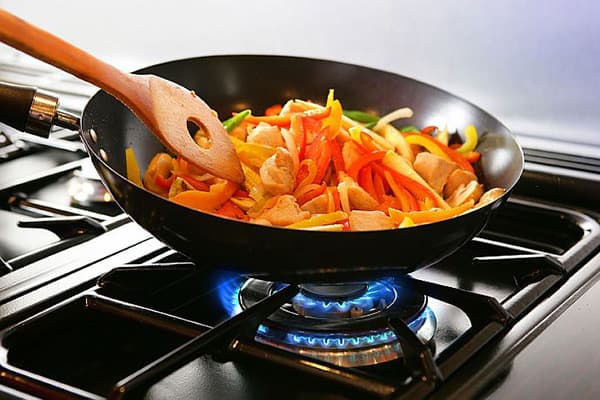
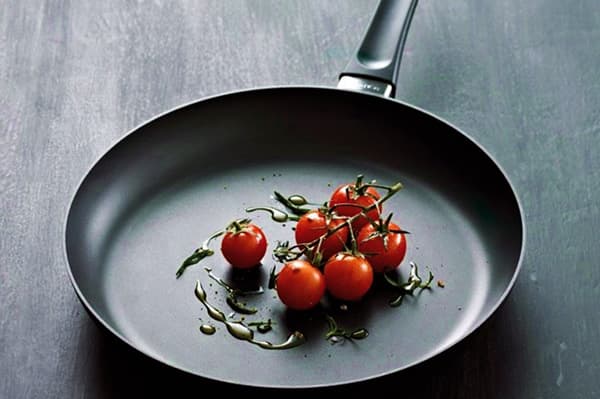
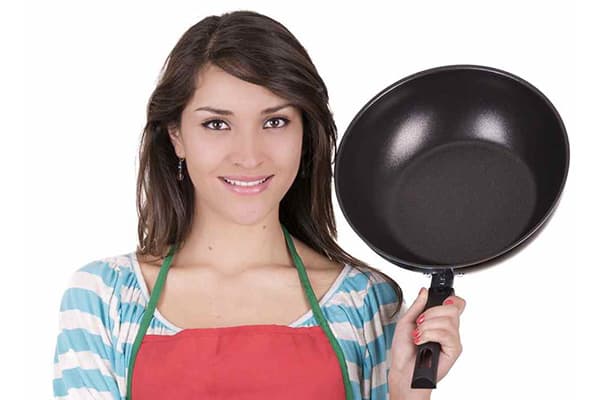
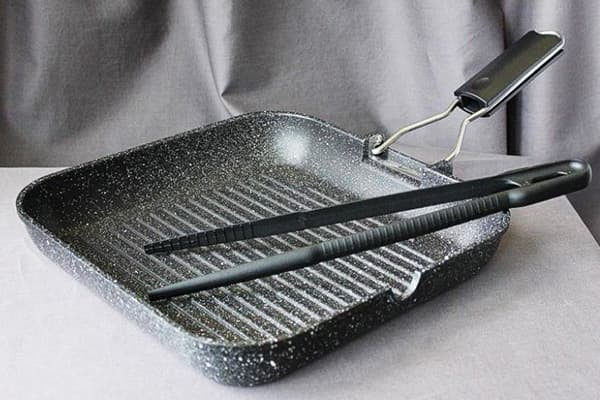
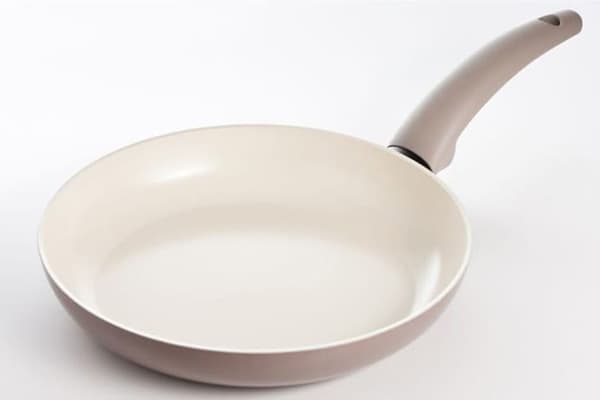
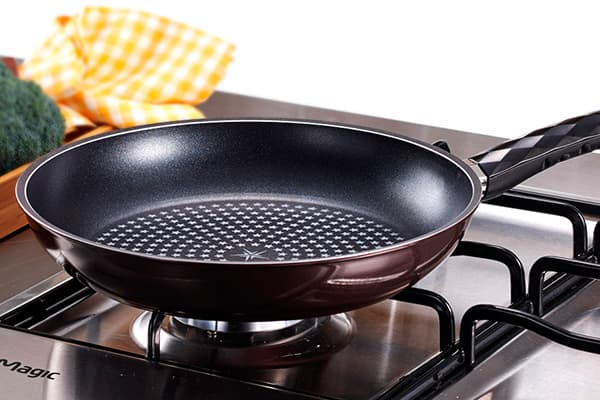
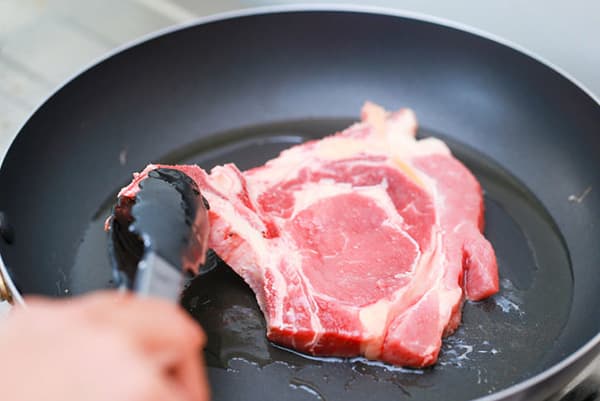
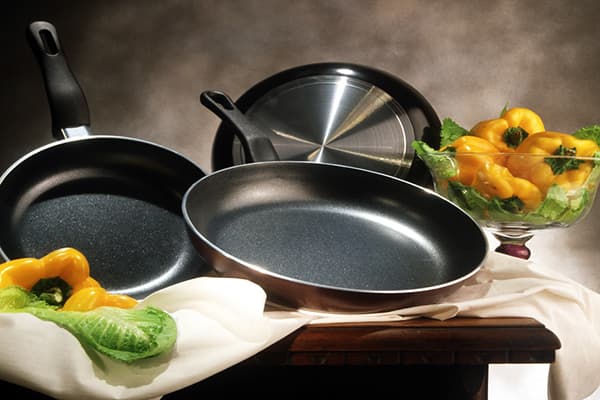
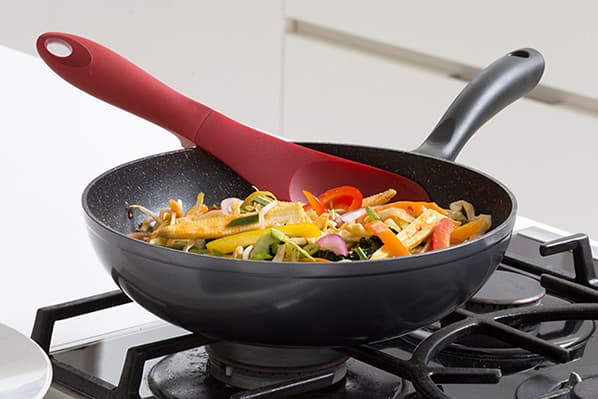
Teflon is a plastic harmful to health. Ceramic coating - for one year, according to personal experience, you can throw it further. Cast iron is the most environmentally friendly, we have one pan for 60 years at home. Stainless steel is even less practical for cooking. Everyone else from the evil one